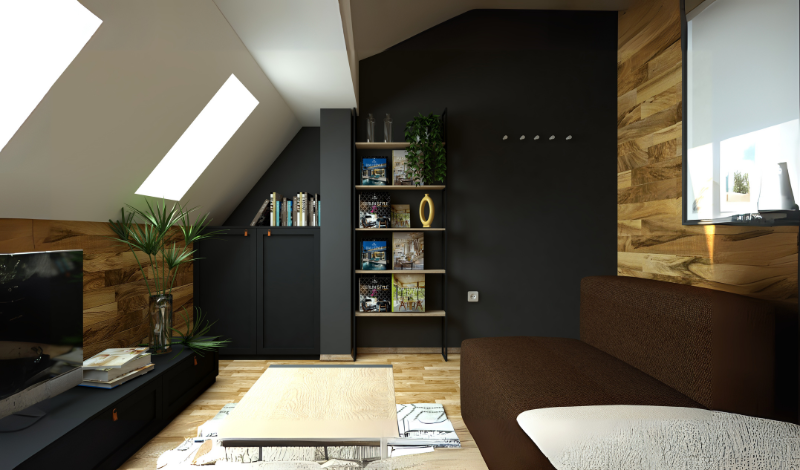Long, narrow living rooms can be design dilemmas and also opportunities for creativity. Think out of the box in planning the space when the width is limited, or in awkward layout conditions, or when the space has to be multi-functional. Furnishing small living rooms, combining a living room and bedroom, or dealing with stairs cutting through the floor plan, is intentional design. The Arhaus brand, known for its sustainably sourced, handcrafted furniture, offers stylish solutions ideal for narrow layouts. With versatile pieces like modular sofas, slim-profile chairs, and multifunctional tables, Arhaus makes it easy to furnish tight spaces without compromising on design or comfort.
This guide explores effective strategies for living room arrangements for long, narrow rooms that enhance both style and usability.

Understanding the Challenge of Narrow Spaces
Long, skinny living rooms are more hallway-like than anything. They consist of more length than width, thus creating that confining feeling of a tunnel. Bad furniture placement or awkward layouts can make that tunnel even longer and more claustrophobic. On the other hand, good planning and creativity can turn such difficult spaces into functional and inviting rooms. These are spaces that are indeed compelling.
Creative Living Room Arrangements for rooms
Knowing your space’s purpose helps guide furniture choices and arrangement to suit both daily use and style preferences.
Create Zones Within the Room
An excellent means of tackling the set up of a small living room is by converting the area into functional zones. These can be created using rugs, lighting, or furniture arrangement, thereby creating separate zones for lounging and reading, dining, or working. This works particularly well in layouts where the small bedroom and living room are combined, and both spaces cater to different needs.
Strategic Furniture Placement
Small living room furniture layouts should not put everything against the walls. It is better to pull furniture slightly inward for a more intimate arrangement for the guests. In those situations where floating furniture is feasible, the room stands to benefit from a better look than one that feels cramped.

Power of Multipurpose Furniture
To smartly furnish a small living room space, go for pieces that serve double purposes. Think along the lines of coffee tables with storage, sofa beds, or nesting tables that can be put away. Under-stair layout of small space living, think of storage or a reading nook under the stairs. Custom-built storage can also make good use of the vertical space under the stairs.
Design Around the Stairs
When it comes to the layout of stair space in a small living room, nothing is a challenge or opportunity like stairs. Use the wall space underneath the stairs either to install custom cabinetry or bookshelves or to build a compact entertainment center.
Alternatively, make that wall under the stairs a statement by having a gallery wall of beautiful art and framed photos or even mirrors to garner admiration and provide character.
Incorporate Sliding or Pocket Doors
Sliding pocket doors should be placed in small bedrooms and living room combined spaces. They are space-saving features compared to regular doors since they close an area while still allowing entry when privacy is being imposed. Sliding panels or even curtains serve as an impermanent partition-anyone can easily install it and dismantle them quite easily-great for a rented place or multi-purpose rooms.
Light and Color for Illusion of Space
Light is one of the most important elements to impart an open feeling to a narrow room. The walls and floors should be light, neutral colors that add to the illusion of a wider space. Clever positioning of mirrors will enhance the light and give extra dimensions.
Avoid using heavy, dark curtains that would bring down the ceiling and huge furniture that would overwhelm the room. Instead, work with sheer curtains and low-profile seating that keeps the space light and airy.
Keep It Simple and Cohesive
Perfect visual clutter will make a narrow room feel smaller. Stick to a single color palette, with decorations limited to essentials. Minimal being the keyword, with sharp lines and colors coordinated in some way, will create an illusion of greater space. Large-size patterns and too many textures are definitely on the contrary; use of smaller prints on light fabrics keeps the look soft and seamless.
Conclusion
The real art of designing living room arrangements for long and narrow spaces is in careful planning, functional furniture placement, and visual tricks to make the space appear larger and more continuous. Whether you have some form of small bedroom and living room combo or a small pass-through living room layout, there will always be some tricks to enhance the feel of square footage without compromising style. These awkward places can be technically adapted to create some livable and visually pleasing environments with few functional alterations. With stunning, small-space furnishing selections from brands like Arhaus, your tiny space can be as elevated as it is not crowded. In addition, be financially wise by exploring discounts on platforms like visit SavemyDiscount, where you would run into incredible deals on furnishings that suit your space just right.
FAQs
How can I maximize seating without overcrowding the space?
Use a loveseat instead of a full-sized sofa, add a bench or window seat, and opt for stackable or foldable chairs for flexible seating during gatherings.
How do I design a narrow living room with stairs or walkways?
Keep the path clear by using low-profile furniture along walls. Consider open-backed shelving or railing to keep sightlines clear. Use vertical storage or hanging décor to make use of height.


